
views
X
Research source
Making a Mold of Your Head
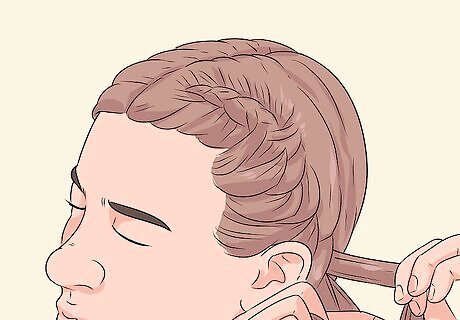
Pull your hair back in the same way you’ll be wearing it under the wig. Some people like to create 1 to 2 French braids, while other people prefer cornrows. How you braid your hair now is very important, because it will affect the size and shape of the wig cap. You need to take a mold of your head in order to modify the wig head. If you don’t do this, the cap for your wig will not fit you. If you already own a canvas head for wig making that has the same measurements as your head, you can skip this part and click here to continue.
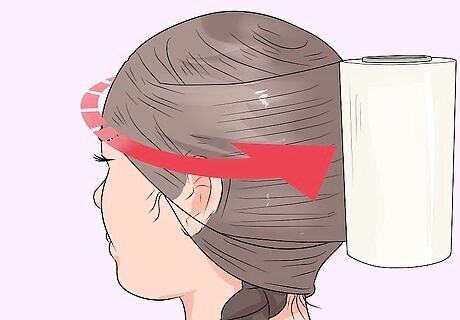
Cover your hair with plastic wrap. Be sure to extend the plastic wrap past your hairline. This includes your ears, forehead, and nape. Extending the plastic wrap past your hairline will reduce the chances of the tape sticking to your hair in the later steps. Use clear plastic wrap, if you can. It will make the later steps easier. If you have a nylon wig cap to wear under your wig, it would be a good idea to put it on first. If the plastic wrap is slipping around too much, secure it to your forehead with a piece of scotch tape.
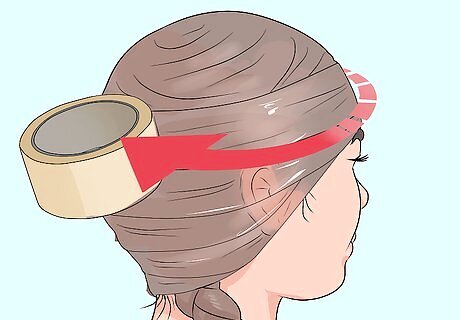
Cover the plastic wrap with 2 layers of clear packaging tape. Wrap the tape around your hairline first, taking care to avoid the skin. Cover the rest of the plastic wrap in overlapping rows of tape. Do this step twice. There should be no soft spots left. If you feel a soft spot, that means you missed the plastic wrap. Cover it with a piece of tape! The taped plastic will have some give to it, which is fine. It should not be soft, like fabric. You need to use clear packaging tape, otherwise you won’t be able to see your hairline in the next step.
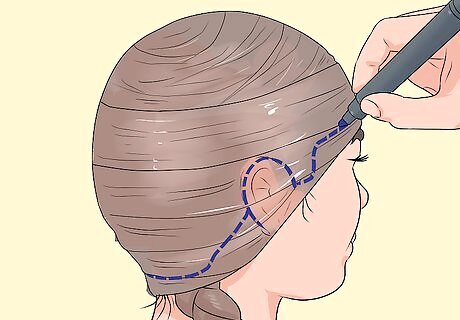
Trace your hairline and ears with a permanent marker. It would be a good idea to get someone to help you with this, especially when you reach the back. If you were to look at yourself in the mirror, you should be able to see your hairline through the taped plastic wrap. Trace all around your hairline, from forehead to nape. Be sure to include your ears as well. Don’t worry about getting the marker on your skin or hair. This is why you extended the plastic wrap past your hairline! If you don't have a helper, turn your back to a mirror, and hold a smaller mirror up in front of you so that you can see the back of your head.
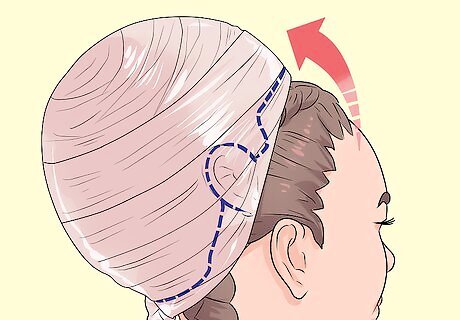
Remove the tape-covered plastic wrap. You should be able to simply slide it off of your head. If you can’t, dip your finger in water, then run it along the inside edge of the cap to separate it from your skin. If you still can’t get the plastic off, carefully cut a slit into it (preferably the back), then slide it off. If you put a nylon wig cap earlier, it may come off with the plastic wrap mold. Simply peel it away.
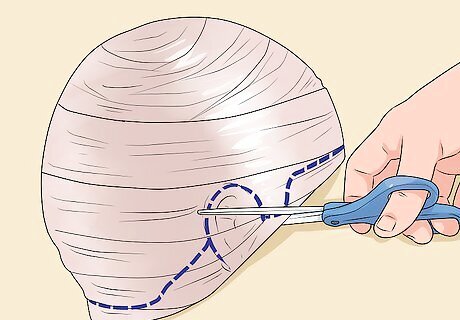
Use a pair of scissors to cut off the excess tape and plastic wrap. Follow the line that you drew with a marker, leaving a ⁄2 to 1 in (1.3 to 2.5 cm) border. Make sure that you cut out the ears as well. When you are done, you should have a cap that fits perfectly on your head, and follows your hairline and ears.
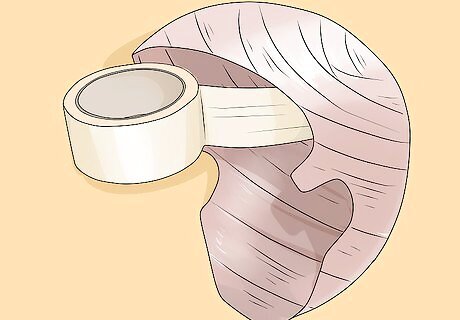
Reinforce the inside of the plastic mold with more tape. If you cut a slit into the mold, you will need to close it up and tape it first. Next, cut off smaller pieces of tape, and use them to cover the inside of the mold, overlapping them as you go. If you want a nicer finish, you can wrap tape around the cut edges of the cap.
Modifying the Mannequin Head
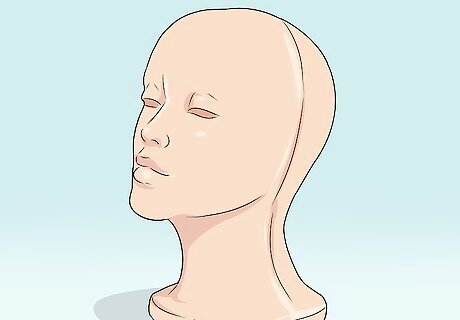
Get a Styrofoam wig head. You can buy Styrofoam wig heads online, in well-stocked arts and crafts shops, wig shops, and in come beauty supply stores.
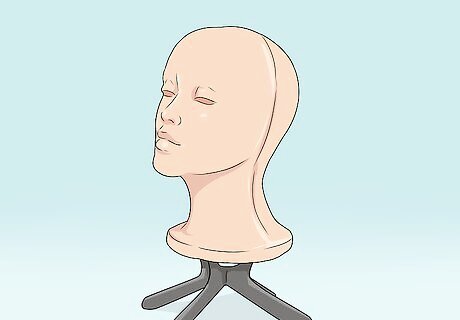
Place the wig head onto a wig stand. You can find wig stands online and in wig shops or some beauty supply shops. It can be the tall kind that you put on your floor, or the shorter kind that you mount onto the table. If you don’t have a wig stand, insert a dowel into a Christmas tree stand, and use that instead. You can also insert it into a bucket filled with rocks. If you need a tabletop DIY wig stand, you can use a paper towel holder instead. You may have to break off the outer stick that touches the outside of the paper towel, however.
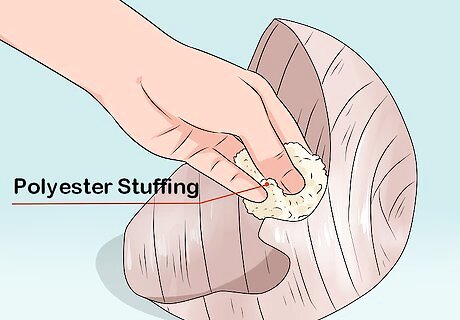
Pad the inside of your head mold so that it will fit the wig head. You can do this with polyester stuffing, paper towels, or even cotton pads. How much you pad it depends on how big your head is compared to the wig head. Most Styrofoam wig heads are small, so you may need to pad your mold a lot. If you choose to use paper towels or even pieces of paper, be sure to crush them and not fold them. This will make it easier to insert the pins later on.
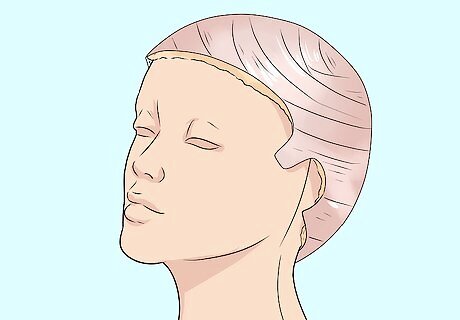
Slide the head mold onto the wig head, and add more padding if needed. Slip the mold with the padding onto the wig head. It should be padded enough to feel firm when you touch it, without a lot of give. If you see any buckling, you will need to pad the mold out some more.
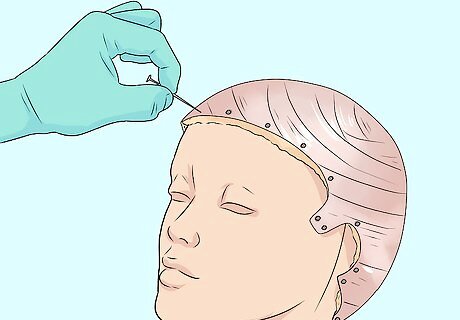
Secure the head mold to the wig head with pins. Place the pins right along the edges of the mold, below the drawn hairline. It would be best if you use the simple, all-metal pins that look like nails. If you use the kind with round, plastic or glass beads on the ends, you will have a hard time fitting the netting for the wig cap. Once you do this, you are now ready to make a wig cap. You can also secure the head mold to the wig head with tape. Masking tape will work the best for this. If you cover up your drawn hairline, be sure to re-trace it.
Pinning the Wig Cap

Buy a weaving net from a wig making supply store. It would be even better if you bought 2 weaving nets, and stacked them together. This will give you a sturdier base. You can buy weaving nets online and from shops that sell wig making supplies. If you are buying netting from a fabric store, you need enough to drape over your head and cover the hairline, plus a few inches/centimeters extra. You can also use French lace, or other types of lace used for wig making. If you will be ventilating your wig, you should get ventilating lace.
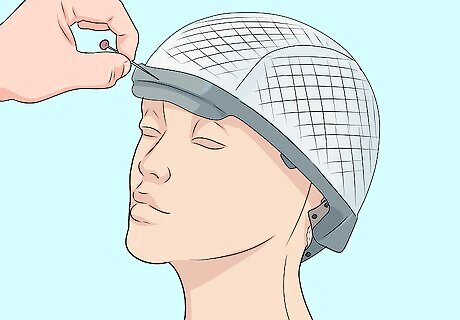
Pull the netting taut across the forehead and secure it with sewing pins. Drape the netting over the wig head, with the front edge 1 to 2 inches (2.5 to 5.1 cm) below the drawn hairline. Pull the netting taut across the forehead, and secure it with sewing pins. You will need a pin at the front-center of the netting as well as a pin at each temple. Insert the pins at a slight angle; this will help prevent the netting from slipping past the pin heads.
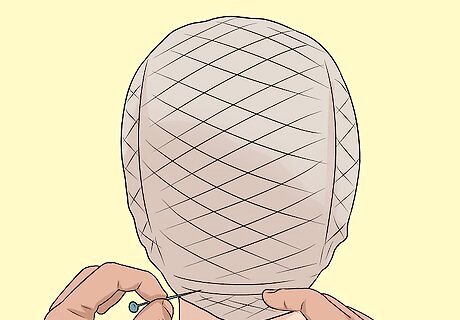
Repeat the process for the back of the wig head. Move towards the back of the wig head. Pull the netting down until it is taut across the top of the head. Secure it to the nape with more sewing pins. Place the pins about 1 inch (2.5 cm) below the drawn hairline.
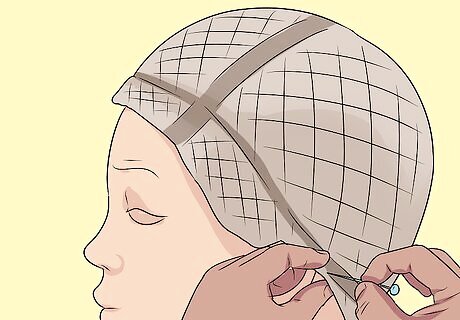
Secure the sides of the netting over the ears. Pull down on the netting as you pin so that it is nice and snug. You need a pin in front of and behind each ear hole. Make sure that the lace is going past the hairline. If it isn’t, it is either off-center or too narrow. If the lace is too narrow, you will need to cut a larger piece and start again. If the lace is off-center, you need to re-position it and re-pin it.
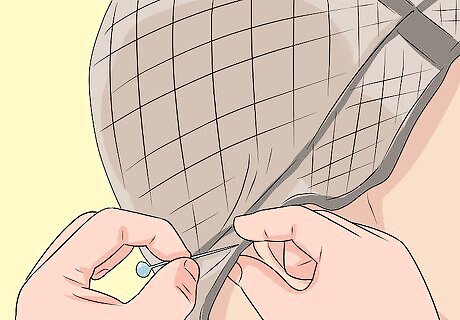
Pinch the netting to create darts and a tighter fit. You will need to create a dart in front and behind each ear. Pinch the edges of the netting so that it lays smoothly against the wig head. Secure the dart with pins, following the curve of the wig head. When you are done, your netting should be laying smoothly across the top of the wig head. Make sure that you are only pinning through the netting. Don't insert the pins into the wig head.
Sewing and Finishing the Wig Cap

Remove the edge pins, then pull the wig cap off of the wig head. Remove the pins securing the netting to the wig head, then slip it off. Do not remove the pins holding the darts together. Do not remove the mold you pinned earlier to the wig head.

Sew the darts using the pins you inserted as a guide. You can do this on a sewing machine, a serger, or by hand. If you are using a sewing machine, be sure to backstitch at the start and end of your sewing. Remove the pins as you sew, and make sure to use a thread color that matches the lace.
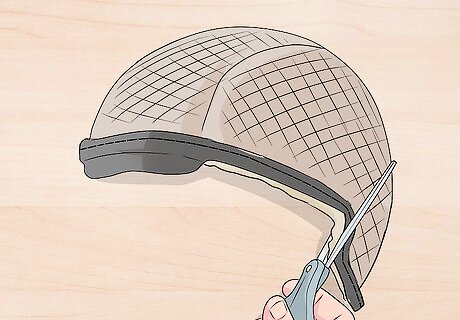
Cut down the seams. If you sewed the darts on a sewing machine or by hand, you will still have triangular flaps sticking out of the seams. Cut these down until the seams are ⁄4 to ⁄2 inch (0.64 to 1.27 cm) wide. Skip this step if you used a serger, as the machine will have already done this for you.
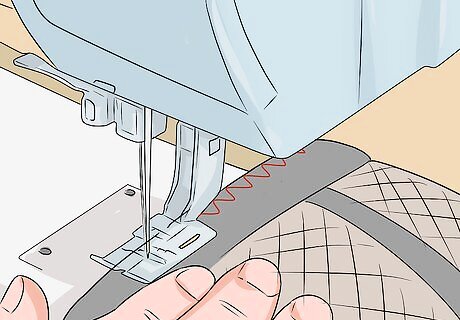
Go over the raw edges using a zigzag stitch, if desired. You don’t have to do this, especially if you used a serger, but it will give you a nicer finish. Remember to use a matching thread color and to backstitch (if you are using a sewing machine). Skip this step if you used a serger. The seams are already finished.
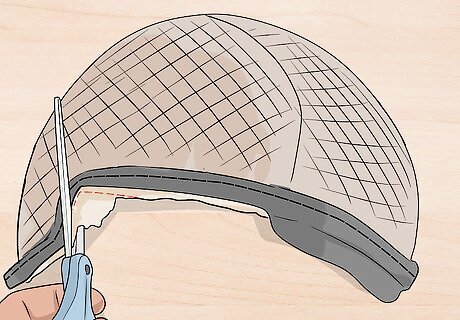
Trim off any loose threads. Go over your wig cap and cut off any loose or hanging threads. If you want an even nicer finish, consider tacking down the seams by hand so that they lay flat.

Finish the wig cap as desired. At this point, you can trim off the excess lace to match the hairline. You can also hem the lace, as desired, or sew in an elastic. You can also sew a stretch or ventilating panel to the top, then cut the netting out from under it. If you are making a lace front wig, do not trim off the excess lace along the front hairline. You will need this to glue the wig down.




















Comments
0 comment